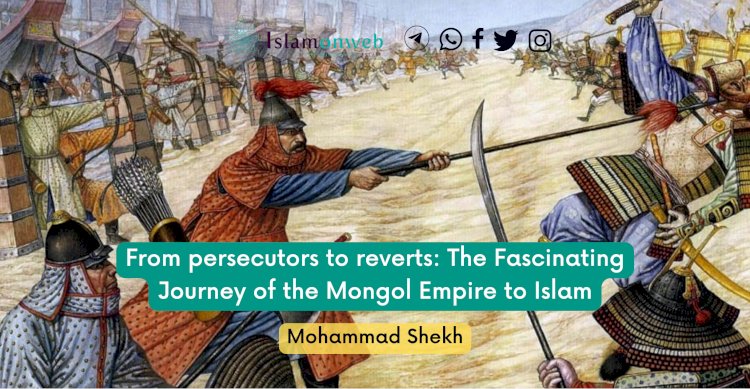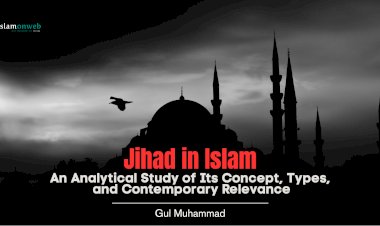From persecutors to reverts: The Fascinating Journey of the Mongol Empire to Islam
The Mongol Empire, known for their Nomadic warriors, sophisticated weaponry, and brutal tactics, was one of the most destructive kingdoms ever built in the world by the incumbent Mongol chieftain Genghis Khān as a world empire. Over a very short period of time, with the destructive approach towards the world, this empire succeeded in expanding to vast territories spanning from Asia to Europe and greatly influencing the cultures and religions of the places they took over. Islam, in particular, had a big impact on the Mongol Empire’s changes. Later on, when Genghis Khān divided his vast empire into his four sons, namely Tolui Khān with Eastern Mongolia, Jochi Khān with Western Irtysh (region of Serbia to southern Russia), Chagatai Khān with Turkistan and Transoxiana, and Ögedei Khān with Western Mongolia, little by little the Central Mongol Empire started to fall apart and consequently separated into four independent empires. Even so, Ögedei Khān settled in Karakorum as the supreme Khān of the entire Mongol Empire; his brothers independently ruled their respective areas under the patronage of Great Khān.
According to Karen Armstrong, the separation of Mongol into four largest empires (i.e. Il Khānate, Golden Horde, Yuan Dynasty, Chagatai Khānate) was the greatest upheaval in the Middle East since the Muslim invasion. But, unlike Muslims the Mongol didn't bring any spirituality with them nor any religion; they were tolerant to all religions, nonetheless, they tended towards Buddhism. Moreover, Genghis Khān introduced the Yasa, which was the Mongol’s legal code, but it was mainly focused on military matters and thus it didn’t work for the people they ruled. As an alternative, they assimilated to the culture and traditions of the region they moved to as a principal constituent of their laws and policies. Hence, by the late thirteenth century and early fourteenth century, the Mongols were influenced by Islam and thus a huge margin of them had become Muslims. This shift in religion made the once strongest enemies of Islam into a dominant Muslim power in the heartlands of the Islamic world.[1]
Influence of Islam under the Mongol Empire
Islam in China
During the rule of Kublai Khān, the first ruler of the Yuan Dynasty of China, Buddhism was the preferred religion, as the Chinese Mongols embraced Chinese culture, traditions, and Buddhism as their religion. However, there were Chinese Muslims from Turkistan and Iran who remained devoted Islam and played a significant role in spreading Islam in China during that time. Among the notable Chinese Muslim figures of this era was Shams al-Dīn ‘Umar (1210-1279), commonly known as Sayyad Ajal, who worked for the Chinese Government as a financial reformer and later was appointed as Governor of Yuan Province connected with Burma. He established two mosques, and the area became a central place for Chinese Muslims. Another important figure was Emir Ahmad Bitniki, a relative of Sayyad Ajal, who worked on paper currency between 1276 and 1282. Additionally, Emir Mahmood Vailawish served as the Governor of Kipling from 1238 to 1254. These individuals made significant contributions to the growth and influence of Islam in China during that period.
Apart from being an important part of diplomacy and politics, Muslims were forerunners in the Chinese military. It is indeed true that some of these Chinese Muslims were pioneers in the invention and use of explosives, specifically gunpowder. Among the notable figures was the Turkish-born Army General, Ali Yahya Uighuri, who served in the Yuan Mongol military during the reign of Kublai Khan. It is to be entertained that even after such a magnificent influence of Islam in various aspects of Chinese society, the Yuan Dynasty didn’t revert to Islam completely. Rather, Buddhism remained as the major religion within the Yuan Empire, particularly in modern-day China.
Islam in Chagatai Khānate
From the Chagatai Khānate, the first ruler to embrace Islam was Baraq (1266–1270). After two years of being Khān, Ghiyath al-Dīn as Muslim, Baraq invaded Khorasan from IlKhānate, but after his death his successors returned to their old religion. It was not until the rule of Aladdin Tarmashirin (1331–1334) when Islam took root in the Chagatai Khānate and after him, every ruler of Chagatai Khānate became Muslim. The acceptance of Islam received more advantages and became dominant during the reign of Qazan Khān ibn Yasaur (1343–1346). But it was during the time of Tughlugh Timur (1348–1363) in Moghulistan[2] that the entire Chagatai Khānate fully reverted to Islam between 1358–1363.
Sarwat Saulat writes: “Like Chagatai Khānate, the Mongols of Kipchak Russia and Iranian IlKhānate waited no longer to accept Islam; on these way, within hundred years of Genghis Khān’s invasion of Muslim World, those who destructed the Islamic World were now the saviour and propagator of Islam”.
Islam in IlKhanate
Hülëgü Khān became the ruler of Iraq and Iran after demolishing Baghdad and the fall of the Abbasid Empire. He followed Buddhism, and his mother and principal wife were Christians, which led him to favor Christianity in many ways. In the views of Professor Masudul Hassan, while Baghdad was collapsing and the people of Iraq and Iran embarked on Islam, Christians took advantage of the opportunity to propagate their religion, after all the Mongols didn’t have any new religion exposed to them. Under the patronage of Mongol, Christians built several churches and tried to convert people into Christianity, but they failed in their attempt.
Despite Hülëgü's inclination towards Christianity, he had to appoint Muslim ministers in his cabinet, such as Saif al-Dīn Khwārazmi, Shams al-Dīn Juwaini, and Ata Malik Juwaini. Eventually, the Ilkhanate reverted to Islam with Tekuder (1282–1284), who was the younger brother of Abaqa (1265–1282) and the son of Hülëgü. Being a Muslim, Tekuder cultivated a good friendship with the Egyptian Mamluk Sultanate.
Islam in the Golden Horde Khānate
Batu Khān (1227–1255), declared himself a Khān and established an empire called Altin Orda (Golden Horde) named for the splendour of its courts. He founded a new city called Sarai and made it the capital of his Khānate. During the reign of the Golden Horde, Sarai became a prosperous city, bringing in significant affluence in the history of the region.
After the death of Sartaq (1255–56) who died on the way to Sarai, Berke (1257–1266) was announced as the Khān in 1257. He is considered one of the greatest Mongol Muslim rulers. He reverted to Islam during a challenging time in Islamic history, which brought about a resurgence of the faith among the Muslims. With Berke’s embrace of Islam, the Mongols became the leading Muslim power in promoting Islam across Eurasia and Eastern Europe. His reign had a profound impact on the spread and influence of Islam in the region.
From persecutors to Promoters of Islam
The Mongols had a swift and devastating impact on the Muslim world, terminating numerous cities and disassembling several Muslim dynasties in a relatively short period of forty years. The Mongol incursions into Muslim territory began with the initial campaigns of Genghis Khān and his sons in north-eastern Iran between 1219 and 1222, when they left many thriving cities of the region to complete ruins.[3] The Mongol conquests had far-reaching consequences for the political landscape and cultural history of the Muslim world.
In 1255, a grandson of Genghis Khān , Hülëgü Khān , was ordered by the new Mongol ruler to eradicate all remaining Muslims between Iran and the Mediterranean[4], which culminated in jaunts into Syria and Iraq, and ultimately the fall of Baghdad in 1258. Hülëgü was determined to keep expanding his rule, and he defeated and ruined the remaining Islamic territories, which included Egypt, Syria, and the sacred cities of Mecca, Medina, and Jerusalem. These conquests caused significant devastation and had a profound impact on the Islamic world and its historical development.
It was Berke Khān, who was outraged and offended by Hülëgü’s attacks on Muslim cities, particularly the destruction of Baghdad, decided to fight back and retaliate, ordering his brilliant general Nogai Khān to lead an attack on Hülëgü’s empire, the IlKhānate. According to Rashid-al-Din Hamadani, Berke Khān spoke to his Mongol and Muslim followers, expressing his opposition to Hülëgü’s attack on Baghdad. His words were:
“He (Hülëgü) plundered all Muslim cities and also brought the Caliph’s death. With God’s help, I will hold him accountable for all the innocent blood [5].”
It was not easy for Berke to save Islamdom and oppose Hülëgü. After all, it was Hülëgü who attacked and ruined the city of Baghdad in 1258, securing its name in one of the worst massacres of the Middle Ages, followed by the end of the Islamic Golden Age and the Abbasid Caliphate. Even when Mongols were uniting and dividing, Berke was determined to embark on an open challenge against the entire destructive Mongol Empire and why wouldn’t he be, the tragic event of Baghdad, had deeply affected the innocent people, libraries, palaces, and the entire city as a whole.[6]
In 1263, Nogai Khān, under the orders of Berke Khan, inflicted a great defeat on Hülëgü Khān, and achieved a significant victory over Hülëgü Khān's forces, killing thousands of his soldiers using the weaponries and defences, as well as shoving several of them towards the Terek River, in which they eventually drowned, putting a brake on Hülëgü dark advance towards the Islamic territories.
Berke died between the years 1266-1267, as he fell ill while attempting to cross the Kura River to attack Hülëgü’s son, Abaqa Khān. After his death, he was succeeded by his great-nephew Mengu-Timur. Being remembered as a the savior of Islamic civilization and the Holy Land from Hülëgü Khān’s unstoppable advances, Berke’s actions actions were seen almost like a divine intervention, as he was the only one capable of halting his cousin's destructive and genocidal attacks on Muslim cities.
Conclusion
There are various reasons that influenced the Mongols in embracing religions such as religious tolerance and cultural assimilation. Even when the Mongols were not attracted to the religious affairs and had a little respect for the places of worship of other religions,[7] matters like Islamic governance, law and administration worked as alternatives for them and they found it handy to act accordingly as per these instrumental grounds of influence. Over the period, when they lived with Muslims and their interactions with them increased, they gradually came in contact with Islamic culture and teachings and their interest in Islam started to spark. Moreover, in Islamic regions like Iraq and Iraq, they were forced to keep Muslims scholars and discuss the matters of diplomacy and politics with them, which again influenced the Mongol rulers and netizens maintaining a close relationship with them and progressing with their help and assistance. In fact, these Mongols recognized the practical benefits of adopting Islam.
To summarize, the reversion of Mongol rulers and netizens to Islam was a complex and multifaceted process. It was influenced by interactions with the Muslim world, the practical benefits of adopting Islam, and the personal relationships forged between Mongol leaders and Muslim scholars. Their embracing Islam, provided a unifying force that helped them consolidate their vast empire and integrate the diverse regions and people they had conquered. It allowed them to establish diplomatic and economic ties with other Muslim powers, facilitating trade and cultural exchange.
References
Amitai, R. (2017). The Mongols and the Islamic World: Army, Empire, and Legacy. The Oxford Research Encyclopedia of Asian History.
Boyle, J. A. (1995). The Mongol Commanders and the Muslim Pilgrimage. Bulletin of the School of Oriental and African Studies, University of London, 58(3), 481-495.
Dr. Arnold, History of Expansion of Islam
Frank, A. (2008). The Muslim Response to the Mongol Conquests: The Case of Samarqand, 1220–1250. Journal of the American Oriental Society, 128(4), 641-653.
Jackson, P. (2005). The Mongols and the Islamic World: From Conquest to Conversion. Yale University Press.
Jackson, Peter. “Reflections on the Islamization of Mongol Khāns in Comparative Perspective.” Journal of the Economic and Social History of the Orient, vol. 62, no. 2/3, 2019, pp. 356–87. JSTOR, https://www.jstor.org/stable/26673134. Accessed 26 May 2023.
Morgan, D. (2007). The Mongols. Wiley-Blackwell.
Prawdin, M, The Mongol Empire: Its Rise and Legacy
Soulat, Sarwat. Millat-e-Islamia Ki Mukhtasar Tareekh. Vol. 2. New Delhi: MMI Publisher, 2018. 4 vols.
Endnotes
[1] Armstrong, Karen, A Short History of Islam, p.83
[2] The Chagatai Khanate was split into two parts, western and eastern. However, from 1370 on, the Chagatai Khans were puppets of Timur.
[3] Hugh Kennedy, Mongols, Huns & Vikings (Orion, 2002), 127.
[4] Starr, Lost Enlightenment, 449.
[5] Quoted in David Nicolle, The Mongol Warlords, (Firebird Books, 1990), 119.
[6] Justin Marozzi Baghdad: City of Peace, City of Blood (Penguin Books, 2014), 176–177.
[7] Ibn Athir, The Chronicle of Ibn al-Athir for the Crusading Period,208.
Disclaimer
The views expressed in this article are the author’s own and do not necessarily mirror Islamonweb’s editorial stance.
























Leave A Comment